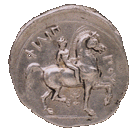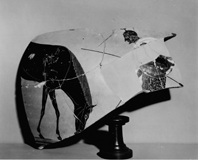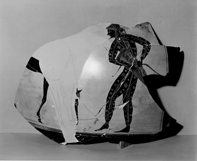Men's Life
Horses

 With very little good pasture land available, horses
were only owned by very rich people throughout all of Greek history.
They were used mainly for the wealthy people's pastimes of hunting
and racing in peacetime, and for cavalry service during wartime.
During the Trojan War the Homeric heroes on both sides rode into
battle in two-horse chariots and exchanged horses as high-status
gifts. At the beginning of the 6th century BC the second class of
citizens in Athens, the Hippeis (meaning "Knights"), were required to
own horses and to serve in the cavalry. The cavalry´s role was
vitally important to Greek military tactics.
With very little good pasture land available, horses
were only owned by very rich people throughout all of Greek history.
They were used mainly for the wealthy people's pastimes of hunting
and racing in peacetime, and for cavalry service during wartime.
During the Trojan War the Homeric heroes on both sides rode into
battle in two-horse chariots and exchanged horses as high-status
gifts. At the beginning of the 6th century BC the second class of
citizens in Athens, the Hippeis (meaning "Knights"), were required to
own horses and to serve in the cavalry. The cavalry´s role was
vitally important to Greek military tactics.
The value placed on horses is shown their role in
art and religion. Small bronze and terracotta votive horse figurines
were used as the handles on the lids of 8th century BC vases. At the
Sanctuary of Zeus in Olympia and elsewhere in the Geometric period,
they were dedicated to the gods as high-status gifts. They continue
to be shown on coins and in art throughout Greek history.

 Attic Black Figure Amphora (Fragments)
Attic Black Figure Amphora (Fragments)
ca. 540&endash;530 BC
Orvieto, Italy
MS 4873a and MS 4873b
On one side, an armed Greek warrior gazes at his horse.(larger
version) The other side depictes a Scythian with his grazing
horse.(larger
version) Drawn by one of the truly great masters of Greek vase
painting, these small, warm&endash;blooded and finely boned animals
are the descendents of an equine type first brought into the
Mediterranean region in the early 2nd millennium BC The Scythian
attendant is dressed in stereotypical nomadic costume.
UM negs. 41406&endash;41407






The Ancient Greek World Index



